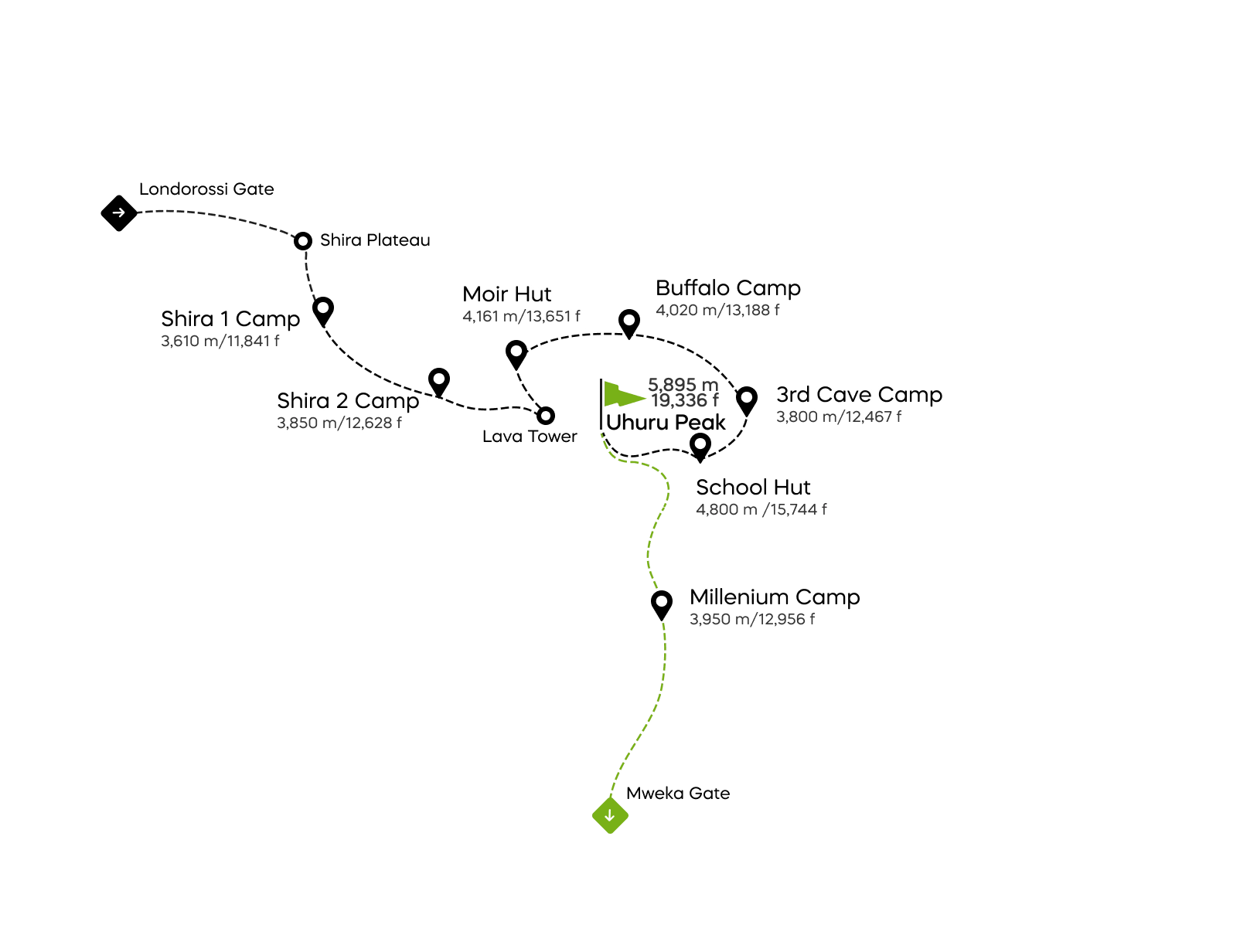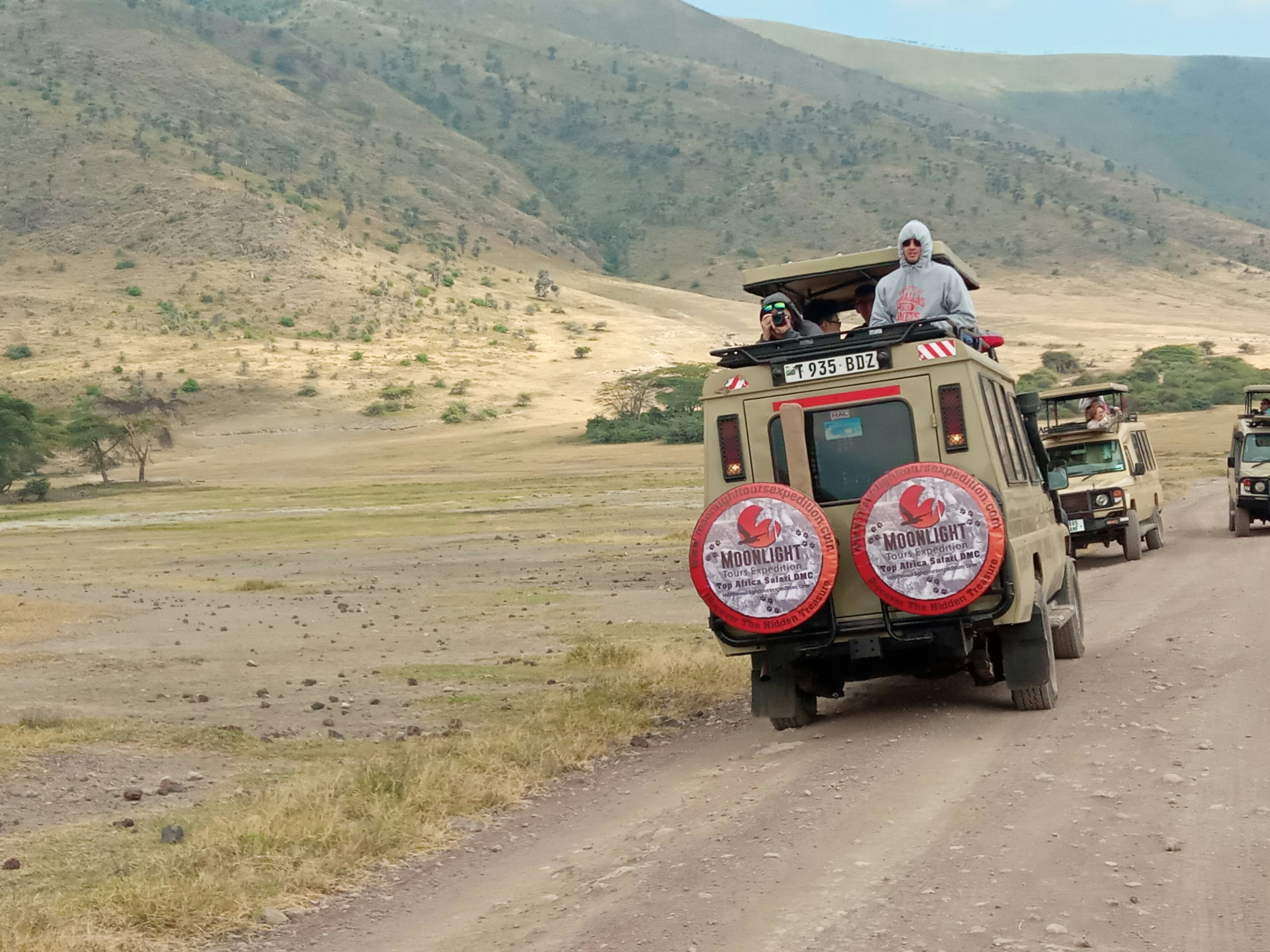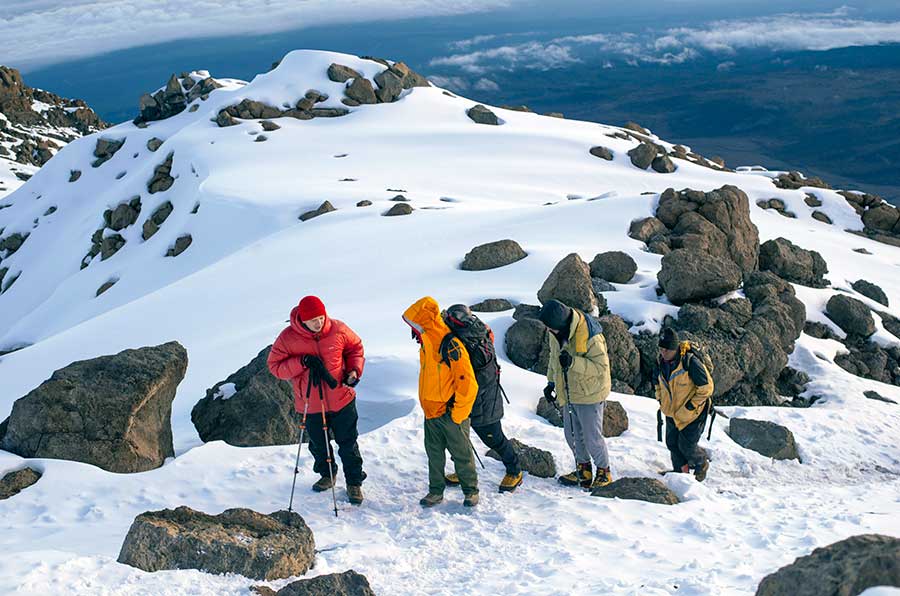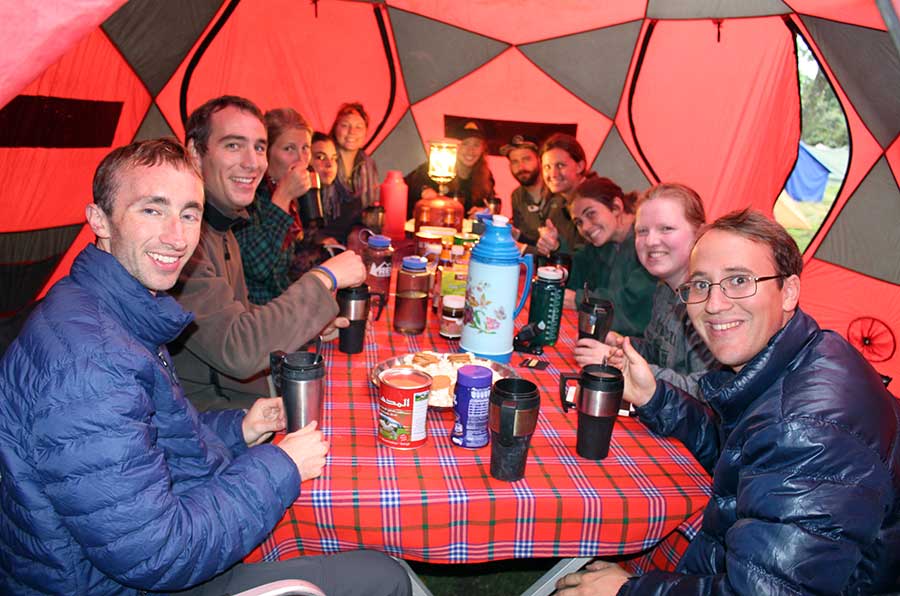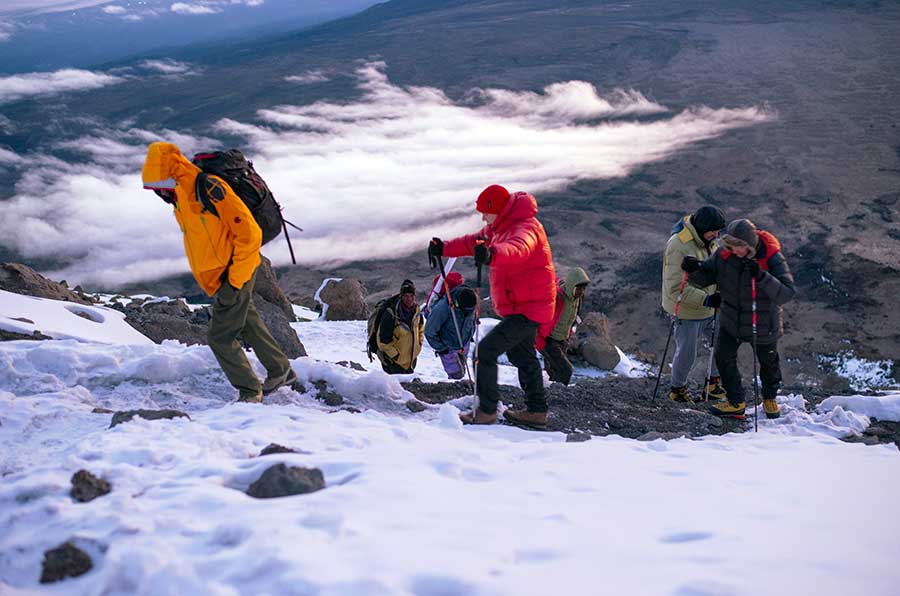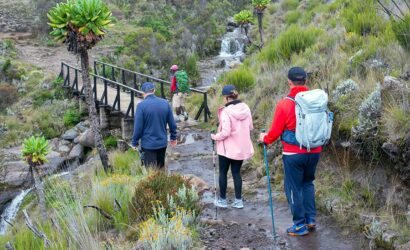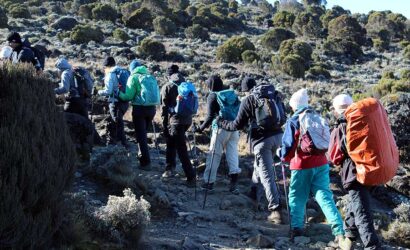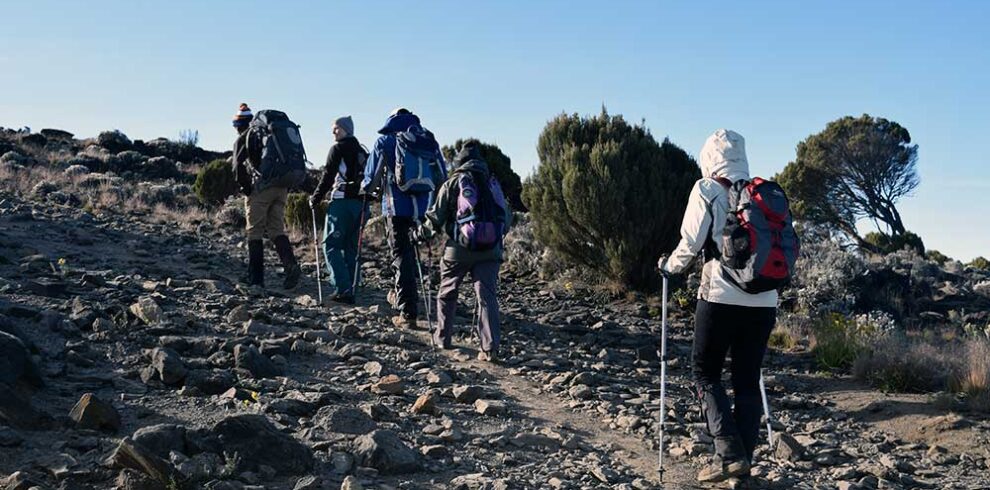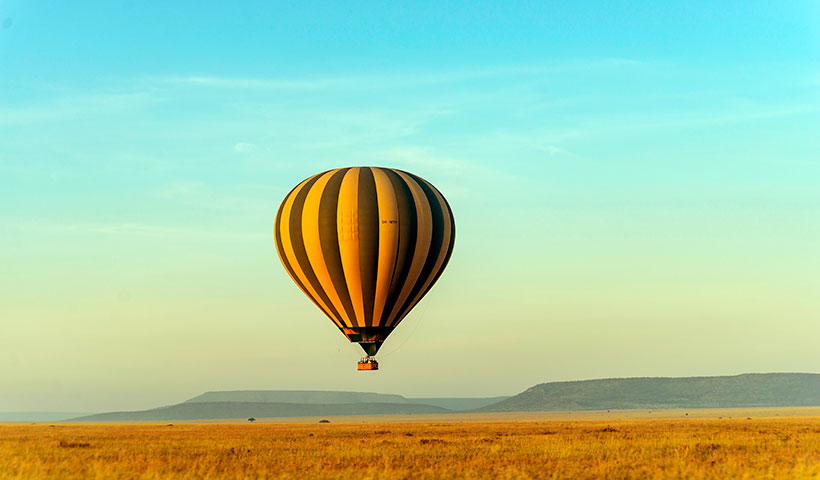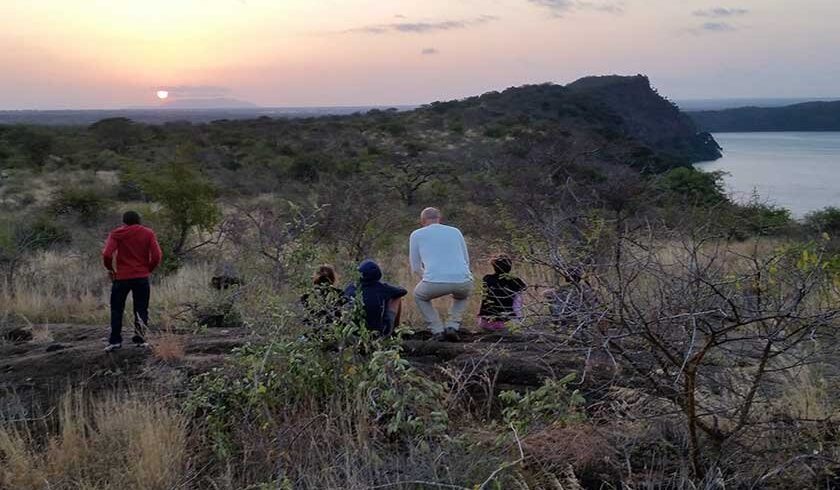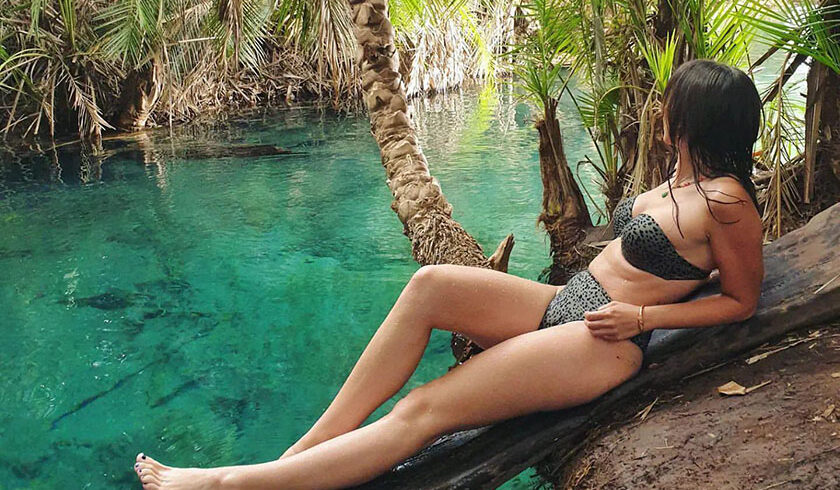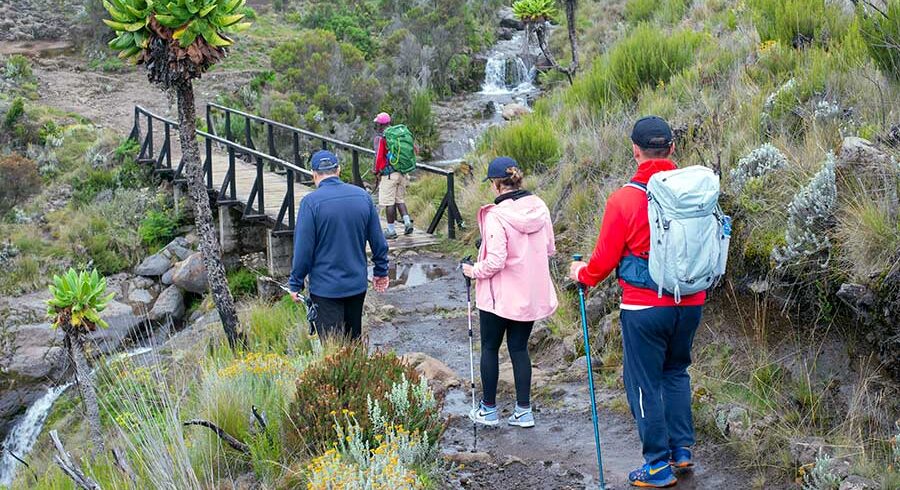Overview
The Northern Circuit is the newest route up Kilimanjaro and also the longest. Because of its length, the Northern Circuit has the highest summit success rate. The route follows the same as the Lemosho Route for the first two days and then veers off to circle around the quieter northern slopes to the east side of the mountain. Northern Circuit approaches the summit via Gilman’s Point before descending on the same route as the Machame and Lemosho.
Tour Highlights
- Departure and Return Place: Moshi Town to Lemosho Gate and then back to Kilimanjaro International Airport (Google Map)
- Departure Time: Please be ready by 8:15 AM for a prompt departure at 9:30 AM.
- Return Time: Approximately 10:30 AM on the last day.
- Dress Code: Casual. Comfortable athletic clothing, hiking shoes, hat, cold weather jacket, gloves, pants, and spare clothing.
- Accommodation: Two nights of accommodations based on Bed and Breakfast at 3 stars hotel (upgrades on request).
- Customizations: Can be customized upon request, to meet traveller’s needs
- Extensions: Trip Extensions are available on request.
- Trip Availability: All year round.
Itinerary
If you have opted for the optional airport transfers, we will pick you up from Kilimanjaro Airport or Arusha Airport and transfer you to your hotel in Moshi.
Pre-trek briefing at your Moshi hotel. You should be planning to arrive at least one day before the start of the trek. Today we will spend in having a pre-trek briefing. We will also review your equipment and rent any equipment which is needed.
After breakfast and briefing, drive to Londorossi Park Gate (about a 3-hour drive). From here a forest track requiring a 4WD vehicle leads to Lemosho Glades. Walk along forest trails to Mti Mkubwa (big tree) campsite.
Elevation: 1830m/6000ft to 2650m/8700ft
Distance: 6km/4mi
Hiking Time: 2-3 hours
Habitat: Montane Forest
Meals: Lunch and Dinner
After breakfast, we continue as the trail gradually steepens and enters the giant heather moorland zone. After several streams are crossed we continue over the Shira Ridge then gently downwards to Shira 1 camp located by a stream on the Shira Plateau.
Elevation: 2650m/8700ft to 3500m/11,500ft
Distance: 8km/5mi
Hiking Time: 4-5 hours
Habitat: Moorland
Meals: Breakfast, Lunch and Dinner
After breakfast, a gentle hike across the plateau leads to Shira 2 camp on moorland meadows by a stream. A variety of hikes are available on the Plateau, making this an excellent acclimatization day.
Elevation: 3500m/11,500ft to 3850m/12,600ft
Distance: 8km/5mi
Hiking Time: 4-5 hours
Habitat: Moorland
Meals: Breakfast, Lunch and Dinner
This day is a long trek heading east which passes through the ‘Garden of the Senecios’ and then enters the high alpine desert zone. The morning is spent trekking up to Lava Tower and the iconic Shark’s Tooth rock formation at 4,600 meters, where you will have lunch. After lunch you will join the Northern Circuit heading down to Moir Camp at 4,200 meters. This is an important day in your trek as you will get to experience high altitude and then sleep low, which is good for the acclimatisation process.
Elevation: 3850m/11,500ft to 4200m/13780ft
Distance: 14km/8mi
Hiking Time: 5-7 hours
Habitat: Moorland
Meals: Breakfast, Lunch and Dinner
Today, we encountered a moderately steep climb out of Moir Valley. We can do an optional hike to the summit of Little Lent Hill at 4,375 meters before returning to the Northern Circuit trail. From here the route follows a series of inclines and declines, skirting around the northern slopes of Kibo to Buffalo Camp.
Elevation: 4200m/13,780ft to 4020m/13,188ft
Distance: 12km/7mi
Walking Time: 5-6 hours
Habitat: High Alpine
Meals: Breakfast, Lunch and Dinner
We start the day with a climb up the Buffalo ridge and down into Porfu Camp where lunch is usually served. The route then continues east around the northern slopes to the Rongai Third Cave. The trek is shorter than the day before and by now you should be feeling well acclimated to the altitude. You will arrive at the Third Cave just around mid-afternoon.
Elevation: 4020m/13,188ft to 3800m/12,467ft
Distance: 8km/5mi
Climbing Time: 5-7 hours
Habitat: High Alpine
Meals: Breakfast, Lunch and Dinner
Today involves a steady incline up and over the Saddle which sits between the peaks of Kibo and Mawenzi Peak. Trekkers then continue walking south-west up to School Hut. After arriving at School Hut you will be served an early dinner and then you should get some shut-eye as you will be awoken before midnight to start your summit attempt. Remember to prepare all your gear, including warm clothes, insulated water bottles, snacks, headlamp and camera before going to bed.
Elevation: 3800m/12,467ft to 4800m/15,748ft
Distance: 15km/8mi
Climbing Time: 4-5 hours
Habitat: Alpine Desert
Meals: Breakfast, Lunch and Dinner
You will be awoken around 11:30 with hot tea and biscuits and will then begin the steep incline up the slopes of Kibo under the cover of darkness. Your first check-point is Hans Meyer Cave where you will take a short break. The climb steepens as you approach Gilman’s Point (5,681 meters), which will be around 5-6 hours after departing School Hut.
Take a moment to enjoy the approaching dawn and incredible view out and across to Mawenzi Peak, but remember you still have 2 hours trekking to reach Uhuru Peak so dig deep for the energy. The slope flattens as you head west around the crater rim and you should arrive at the summit at or just after sunrise.
Your stay here will be brief so get as many pictures as you can of the incredible views and surrounding glaciers. You will then retrace your steps back around the crater rim to Stella Point (5,739 meters) where you will turn south and head down the heavily screed slopes of Kibo to Barafu Camp (4,680 meters).
Most trekkers take a short break here before continuing down to Millennium Camp (3,950 meters) for your final night on the mountain. In total you will be trekking for 14-16 hours on day eight so it is important to pace yourself, remain hydrated and keep your blood sugar levels up.
Elevation: 4800m/15,748ft to 5895m/19,340ft
Down to 3950m/12,959ft
Distance: 6km/3.5mi up / 11km/6mi down
Hiking Time: 5-7 hours up / 5-6 hours down
Habitat: Stone scree and ice-capped summit
Meals: Breakfast, Lunch and Dinner
After breakfast we continue the descent down to the Mweka Park Gate to receive your summit certificates. At lower elevations, it can be wet and muddy. Gaiters and trekking poles will help. Shorts and t-shirts will probably be plenty to wear (keep rain gear and warmer clothing handy).
Monkey Adventures vehicle will be waiting for you at Mweka gate to drive you back to your hotel in Moshi (around 60 minutes).
Elevation: 3950m/12,959ft to 1680m/5500ft
Distance: 10km/6mi
Hiking Time: 3-4 hours
Habitat: Forest
Meals: Breakfast
Includes/Excludes
Includes
- Quality Mess tents with a table and chairs
- Kilimanjaro summit certificate
- Guides, Porters, Cook salaries and park fees
- Large portions of fresh, healthy, nutritious food
- Camping or Hut fees (part of park fees)
- Emergency Oxygen Cylinder
- VAT (18% charged by the Government)
- All meals while on the Mountain
- Rescue fees (part of park fees)
- All transfers to the mountain and back to your Moshi hotel
- Sleeping Mattress
- Conservation fees (part of park fees)
- Professional, experienced mountain guides
- Clean, purified drinking water
- Quality, waterproof, four-season mountain sleeping tent (on twin sharing basis)
Excludes
- Liquors, beers and bottled beverages
- Hotel (available as an optional addon)
- Personal Expenses (e.g. laundry, telephone, beverages, etc.)
- Tanzania Visa
- Transfers (available as an optional addon)
- Meals not listed in the itinerary
- Surcharge for online payment of advance and balance (5% on each payment)
- Tips and gratuities
- International and domestic flights
- Personal trekking equipment such as sleeping bags, hiking boots, clothes, etc (available for renting)
- Travel insurance
FAQs
Mount Kilimanjaro can be climbed anytime throughout the year. Most travelers prefer climbing during the dry seasons: December to March, June to October. Many consider the best months to climb Kilimanjaro to be January, February, and September.
We are. We are not agents for anybody, but run the treks ourselves through our own Tanzanian company. So you can rest assured that whoever you speak to in our company has climbed Kilimanjaro – and probably many times.
There are at least six routes to the top, Uhuru peak. You will hike between 53 and 73km depending on which route you choose. The shortest and toughest is the 5-day Umbwe route. Allowing extra days will help you to acclimatize better and improve your chances of reaching the summit. The easiest and most popular route is Marangu (which can be done in five), but we use six days for this route.
None, but previous hiking or climbing experience will help. You need to be fit and healthy and have a good pair of worn-in hiking boots. The fitter you are the more you are likely to enjoy it.
Your Kilimanjaro dream climb is entirely your own to design. We will work with you to customize exactly the triumphant Tanzanian mountainous quest experience you want. You go with the people you choose. You leave on whatever day you wish. You decide on your preferred route option, pace, and the number of days you will take.
On most routes, you’ll trek 4-7 hours most days. On certain routes you’ll trek as many as 10-15 hours on the longest days.
Prior to the climb, you’ll enjoy an acclimatization day with wildlife viewing and nature walks. Trekking through the rain forest, you’re likely to spot black-and-white Colobus monkeys, tropical birds and more.
Highly-trained chefs prepare three hot nutritious meals daily, as well as trail snacks and afternoon tea each day. You’ll eat all your meals in a solar-lit dining tent with your fellow trekkers and head guide. Delicious vegetarian, vegan, gluten-free and other specialty meals can be provided (with advance request). We’re happy to send you a sample menu—just ask!
Your mountain camps are set up and broken down each day by expert camp porters. You’ll stay in double occupancy all-weather tents with full-ground pads to keep you and your gear dry. Private toilet tents, solar-lit dining tents with tables and chairs, and basins of hot water for washing are provided in every camp. Grand Traverse treks include upgraded solar-lit walk-in-height sleeping tents with mountaineering beds and mattresses for additional comfort.
We are. We are not agents for anybody, but run the treks ourselves through our own registered Tanzanian local company.
Yes, we do arrange this. Please send your request to Safari.
You will need a passport that is valid at least six months beyond your dates of travel with an entry or re-entry visa, duly endorsed.
The mountain is in Tanzania, East Africa, about 350km from the equator. The nearest towns are Moshi and Arusha.
Mount Kilimanjaro is the highest freestanding mountain in the world and the highest mountain in Africa. Its highest point is Uhuru Peak on the Kibo crater at 5895m above sea level.
Yes, it is expected and much appreciated. The amount depends on the number of days, but can range from $150 and $350 per hiker. Tips are pooled and shared amongst the crew.
Northern Circuit Map
